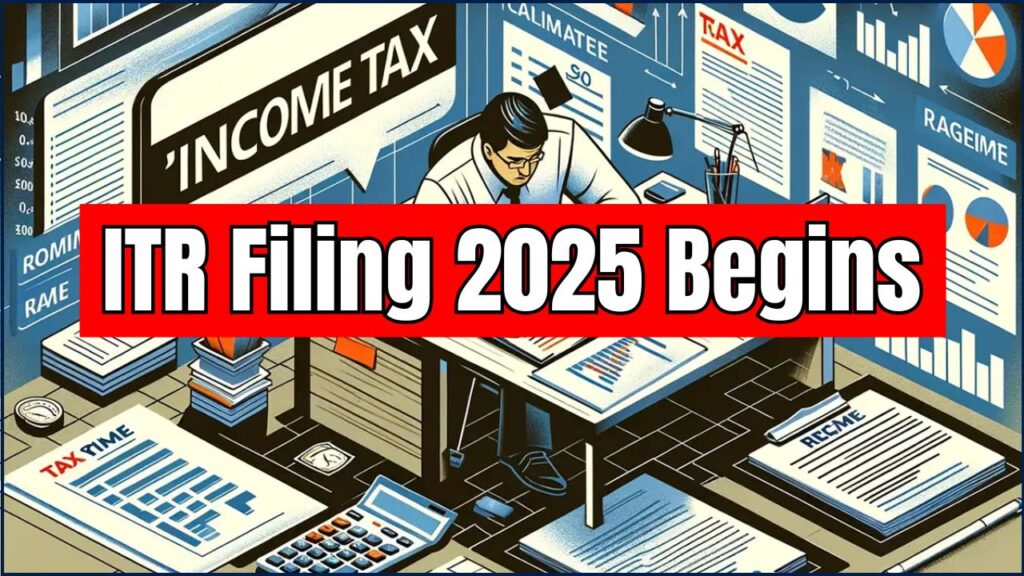Heads up, taxpayers! The clock is ticking for the Income Tax Return (ITR) Filing 2025 season in India, and if you’re planning to file ITR-1 or ITR-4, it’s time to buckle up. Whether you’re a salaried employee, a small business owner, or a first-time filer, this guide is built to help you understand, plan, and act smartly.

We’ve broken down complex jargon, packed in expert advice, and added real-life examples so even a 10-year-old could explain it at the dinner table. And hey, if you’re a tax pro, there’s plenty here for you too.
ITR Filing 2025 Begins
| Feature | Details |
|---|---|
| Applicable Forms | ITR-1 (Sahaj), ITR-4 (Sugam) |
| Start Date for Filing | April 1, 2025 |
| Extended Deadline (Non-Audit Cases) | September 15, 2025 |
| Deadline for Audit Cases | October 31, 2025 |
| Belated/Revised Return Last Date | December 31, 2025 |
| Eligibility (ITR-1) | Income up to ₹50L, salaried individuals, 1 house property |
| Eligibility (ITR-4) | Presumptive income scheme under Sections 44AD, 44ADA |
| Official Website | IncomeTax.gov.in |
Filing your ITR-1 or ITR-4 for FY 2024-25 doesn’t need to be a scary task. The earlier you start, the better your chances of error-free, penalty-free filing. Understand your form, collect your documents, avoid common mistakes, and let the portal guide you. And if in doubt, reach out to a certified tax pro. It’s your money — take charge of it!
What is ITR Filing and Why Does It Matter?
ITR Filing means telling the Indian government how much money you earned and paid tax on during a financial year. It’s like showing your tax report card. The Income Tax Department uses this info to calculate whether you’ve paid the right amount of taxes — too much (so you get a refund) or too little (so you pay up). Filing also helps with:
- Loan approvals (yep, banks love ITR copies)
- Visa applications
- Future investments and credibility
- Building a financial identity for creditworthiness
It’s not just about obeying the law; it’s about being financially smart.
What’s New in ITR Filing for FY 2024-25?
- AIS and TIS improvements: Taxpayers can now see more detailed financial data via the Annual Information Statement.
- Single-window dashboard: IncomeTax.gov now offers a smart dashboard showing pending actions, refunds, and filing history.
- LTCG simplification: Individuals with Long-Term Capital Gains (LTCG) up to ₹1.25 lakh can file under ITR-1 now.
- Updated ITR-U Form: Allows error correction up to 2 years after original filing, introduced with clear penalty structure.

The Evolving Landscape of ITR Filing
The process of filing Income Tax Returns in India has undergone a significant transformation. Historically, it was a largely manual, paper-based affair, often requiring taxpayers to visit tax offices. The introduction of the Income Tax Act of 1961 laid the groundwork, but actual filing was cumbersome.
Pre-2007 (Manual Era): Taxpayers would manually fill out paper forms and submit them physically to the Income Tax Department. This often meant long queues and the risk of errors in transcription. Refunds could take months, sometimes years, to process.
2007 Onwards (E-filing Revolution): E-filing was gradually introduced, starting with certain categories of taxpayers, and eventually became mandatory for most. This shift digitized the process, making it faster, more convenient, and reducing human errors. The e-filing portal (incometax.gov.in) has been continuously updated, adding features like pre-filled data, AIS, and TIS, significantly simplifying the process for millions. The recent extensions by CBDT also reflect an adaptive approach to ensure smooth compliance in a dynamic regulatory environment.
Who Should File ITR-1 and ITR-4?
ITR-1: The ‘Sahaj’ Choice
Use this if you:
- Are an Indian resident (not NRI)
- Earn income up to ₹50 lakh
- Get income from salary/pension, one house property, and other sources
- Don’t have foreign assets or capital gains over ₹1.25 lakh
ITR-4: The ‘Sugam’ Route
Pick this if you:
- Are under presumptive income schemes (Sections 44AD, 44ADA, 44AE)
- Run a small business or freelance/profession
- Earn up to ₹50 lakh from business or ₹50 lakh from profession
Note: NRIs, directors in companies, and taxpayers with complex capital gains should look at ITR-2 or ITR-3 instead.
Step-by-Step Guide to File ITR-1 or ITR-4
Step 1: Gather Your Documents
- PAN and Aadhaar
- Form 16 (from employer)
- Bank statements
- Interest certificates (for savings, FD, etc.)
- Investment proofs (80C, 80D, etc.)
Step 2: Choose the Right ITR Form
Use the ITR utility tool from the Income Tax Department.
Step 3: Log Into the e-Filing Portal
Go to www.incometax.gov.in and sign in using PAN and OTP.
Step 4: Pre-Fill and Verify Your Data
Much of your income details will be auto-filled. Double-check everything. Don’t snooze on accuracy.
Step 5: Claim Deductions
From Section 80C (LIC, PPF, ELSS) to 80D (Health Insurance) and 80E (Education loan), reduce your taxable income smartly.
Step 6: Calculate and Pay Tax (If Any)
If you owe taxes, pay via Challan 280 on the same portal.
Step 7: Submit and E-Verify
After submission, verify online via Aadhaar OTP, net banking, or EVC. No e-verification? Return = invalid.
ITR 1.0 vs. ITR 4.0 – Which One is For You?
Choosing the right ITR form is the first, crucial step. Here’s a simple comparison between ITR 1.0 (Sahaj) and ITR 4.0 (Sugam):
| Feature | ITR 1.0 (Sahaj) | ITR 4.0 (Sugam) |
| Who can file? | Resident individuals | Resident individuals, HUFs, Partnership Firms (other than LLP) |
| Income sources | Salary, Pension, One House Property, Other Sources (e.g., interest, family pension), Agricultural income up to ₹5,000 | Presumptive business/profession income (Sections 44AD, 44ADA, 44AE), Salary/Pension, One House Property, Other Sources |
| Total income limit | Up to ₹50 Lakh | Up to ₹50 Lakh |
| Cannot be filed if… | Total income > ₹50 Lakh, Agricultural income > ₹5,000, Income from multiple house properties, Capital Gains, Foreign assets/income, Director in a company, Unlisted equity shares | Total income > ₹50 Lakh, Income from multiple house properties, Capital Gains, Foreign assets/income, Director in a company, Unlisted equity shares, Carry forward/brought forward losses |
| Key difference | For salaried/pensioners with relatively simple income | For small businesses/professionals opting for presumptive taxation |
Common Mistakes to Avoid
- Filing the wrong form (e.g., ITR-1 instead of ITR-2)
- Not reconciling AIS/TIS with your actual income
- Forgetting to declare interest from savings accounts and FDs
- Skipping e-verification
- Misreporting exempt income like agricultural income or gifts
What Happens If You Miss the Deadline?
Late filing has consequences:
- ₹5000 fine (under Section 234F)
- Interest on unpaid tax (Section 234A/B/C)
- Loss of carry-forward tax benefits
- Trouble getting refunds
Don’t wait until the last week of September — the portal can crash from traffic. File early and stress-free.
Practical Examples
Case 1: Ramesh, the 9-to-5 guy
Ramesh earns ₹40 lakh annually, lives in Delhi, and pays LIC premiums and PPF. He files ITR-1. Takes him under 30 minutes online.
Case 2: Priya, a freelance designer
Priya makes ₹25 lakh from freelance gigs under Section 44ADA. She files ITR-4 and claims 50% income as expenses. Simple, smart, legal.
Case 3: Asha, homemaker turned YouTuber
Asha earns ₹8 lakh a year from brand deals and Google AdSense. She files ITR-4 under Section 44ADA, paying tax only on 50% of income.
FAQs
Q1: Can I file ITR without Form 16?
Yes. Use your salary slips and AIS statement as reference.
Q2: Is Aadhaar mandatory?
Yes, unless you’re an NRI.
Q3: Can I revise my ITR later?
Absolutely. File a Revised Return by December 31, 2025.
Q4: What if I made a mistake?
Use the ITR-U form to correct it within 2 years, but note that it may attract penalties.
Q5: Can I file ITR on my phone?
Yes. Use the official Income Tax India app or mobile browser.








